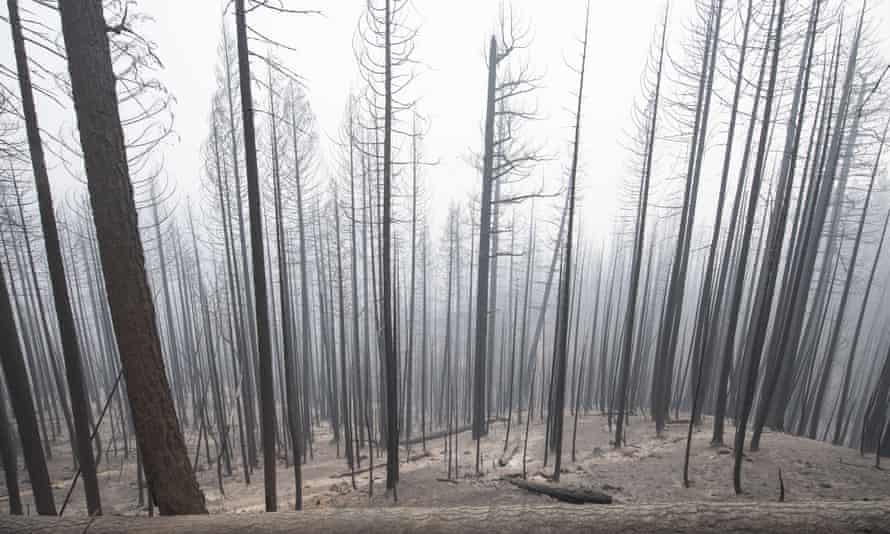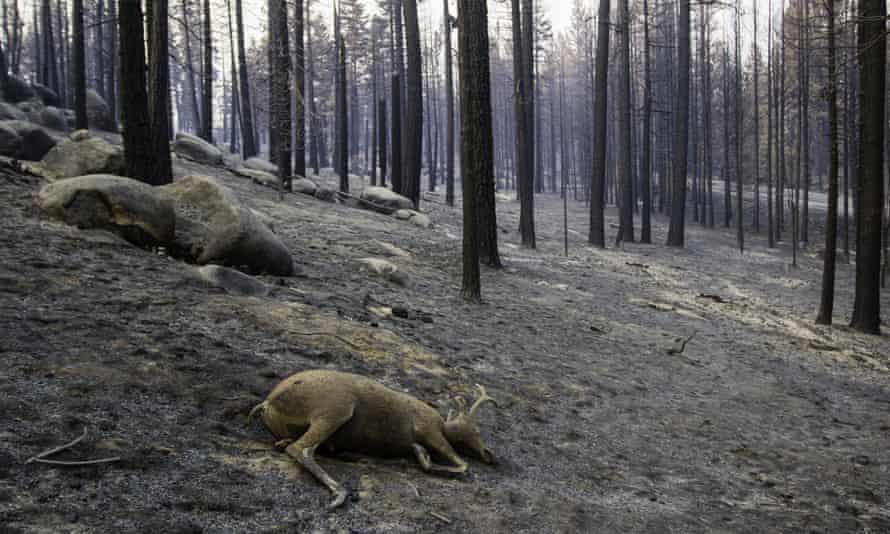The Dixie fire is almost out, but its inhospitable ‘moonscapes’ remain
Severe wildfires are making the recovery process for plants and animals more challenging, sometimes for years after the flames

Last modified on Wed 22 Sep 2021 06.24 EDT
After more than two months, the battle to contain the Dixie fire – a behemoth blaze that swept nearly 1m acres, leveling mountain towns and blackening the conifer-covered landscape – is nearing its end.
But even after the fire crews pack up, threats remain for the plants and animals that call this area home. Scientists are warning that the severity of today’s wildfires is making the recovery process increasingly challenging, sometimes for years after the flames are put out.
The American west has evolved alongside fire, which is a natural part of the landscape. But fueled by warmer, drier conditions and an overabundance of parched vegetation, blazes are increasingly burning more ferociously, consuming nearly everything in their path.
The size but also the severity of today’s wildfires is a growing concern. Fires that exhibit erratic behavior and burn with more intensity are more likely to leave behind only patches of living landscape.
“There is the extent of the fire and there is the intensity of the fire. When you get these big intense fires, you mostly kill those animals,” said ecologist Brad Shaffer, the director of the UCLA La Kretz Center for California Conservation Science. “If you don’t kill them then when they come back and it’s just a big ash field, there are no plants and therefore no insects. They starve to death.”
In these high-severity burns, vegetation on the forest floor is consumed by the flames, and shrubs and stumps are reduced to ash. The soil itself changes, and even beneath the ground, tree roots are burned. These moonscapes can take between five and 10 years to regenerate – far too long for some species to wait.
Scientists are also finding that some landscapes remain permanently changed and trees struggle to grow where they once flourished. Surviving animals, faced with reduced populations after a fire, may resort to inbreeding, ultimately reducing their resilience while the climate becomes less hospitable.

“What you are creating is analogous to an ocean that has a few little islands on it,” Shaffer said. “It is very hard to move across that super burnt landscape in a short amount of time.” For small animals, like the lizards and amphibians he specializes in, “you have to wait for it to come back”.
Shaffer, who is studying how ecosystems recovered in the Woolsey fire, which burned in Los Angeles and Ventura counties in 2018, says research on the issue is still unfolding. But without mitigation, some animals may not be able to adapt.
“It’s a very nasty feedback loop,” Shaffer said. “The result is small, isolated, genetically inbred populations that are often extremely compromised, with less resilience to catastrophic challenges associated with climate change and with little chance of recovery.”
It’s still unclear what’s been left in the footprint of the Dixiefire. The Burned Area Emergency Response (Baer), specialized crews with the US Forest Service staffed by engineers, biologists, archeologists and other highly trained experts, are deploying into the cooled parts of the Dixie scar to assess the damage.
While the official prognosis is yet to come, Brian Rhodes, the deputy director of fire and aviation management with the US Forest Service, says he is optimistic some areas may have been spared the worst.
“There are definitely pockets of high severity but not as broad as one would expect,” he said. “Generally speaking I would anticipate it being a mixture of high severity, moderate severity and maybe in some places low severity.”
Still, researchers have found that fire severity overall is trending in a more dangerous direction.
“We are seeing an increase in the proportion of area burned at high severity with climate change,” said Camille Stevens-Rumann, an assistant professor at Colorado State University who studies fire ecology and recovery. The hot, windy days when high-severity burning is likely have defined the 2021 fire season, and helped fires like the Dixie evade containment efforts for weeks on end.
Those conditions also make it more difficult for forests to heal the ways they once did. Healthy fires tend to burn low to the ground, creeping through the bases of trees and clearing the undergrowth. Severe fires shoot flames hundreds of feet high, scorching the canopies and overcoming natural defenses evolved across centuries. When older trees succumb, seedlings struggle.
“Rather than having some standing trees helping shade the ground and keep it cooler and more moist, it’s just this large expanse of black charred earth which can make it difficult for trees to establish,” Stevens-Rumann said. “There’s a lot of concern about whether these forests are going to have a longer-term conversion, moving away from a forested ecosystem to something else,” she added, explaining that, on this trajectory, once-forested landscapes could soon shift to become shrub-covered chaparral, which is more flammable. Chaparral landscapes, in turn, could convert to grasslands.

This could also mean big changes for the animals that live there. “If we had the spotted owl or another endangered species that is used to a dense dark forest, they are not going to use the shrubland ecosystem in the same way, or perhaps at all,” she said. “We are changing the habitat for a lot of different species.”
Climate change is the main culprit in increasing the intensity of fires but it has not acted alone. A long history of suppressing natural fire – the kind needed to keep forests healthy – has only made the problem worse.
Officials are embracing and implementing badly needed mitigation tools, including forest thinning and prescribed burning, but scientists have said that more urgency and action is needed to slow the changes already under way.
“The more preemptive action we can really do to stop that next large, high-severity fire is the best way we are going to maintain forests across our landscape,” Stevens-Rumann said. “A lot of times that’s fighting fire with fire.”